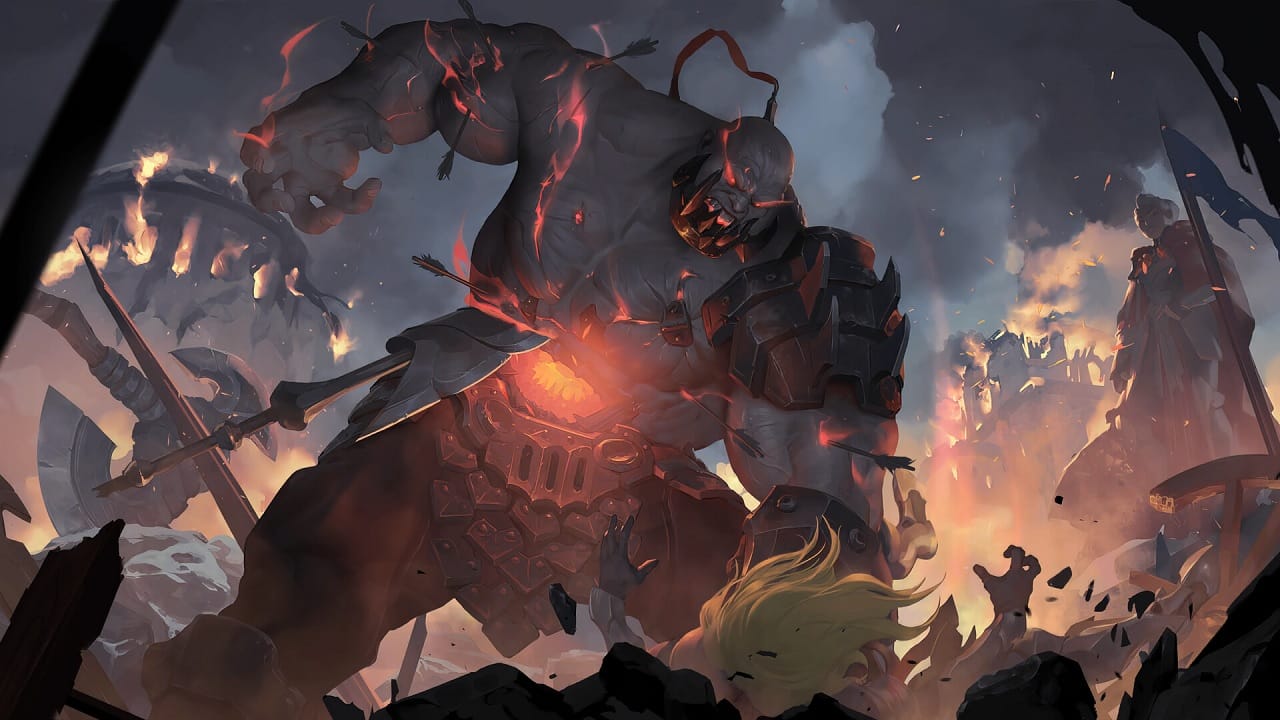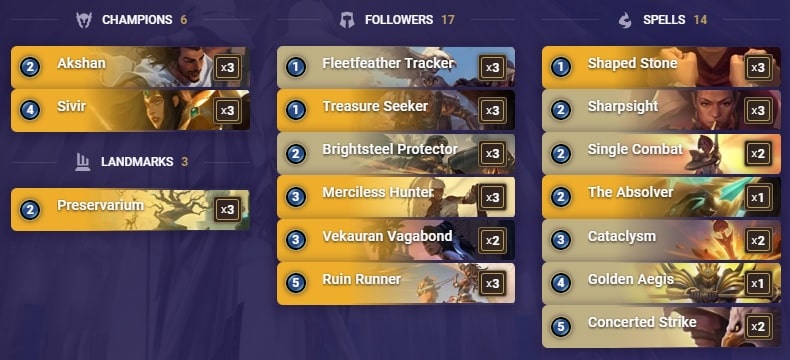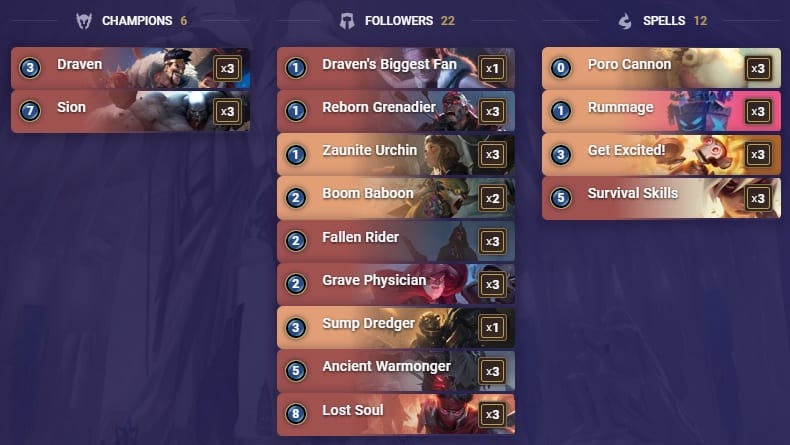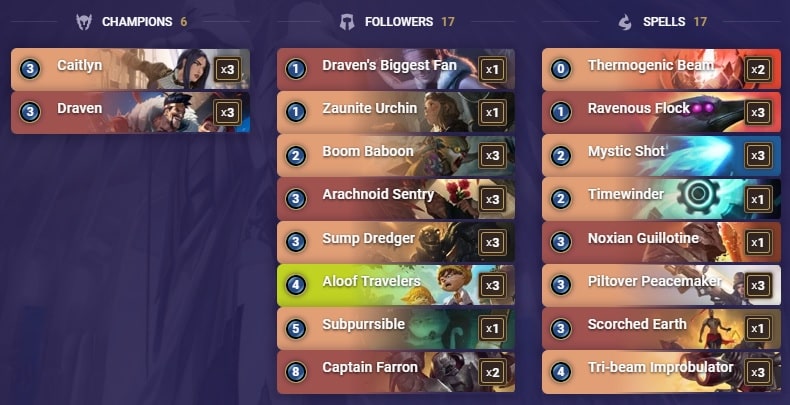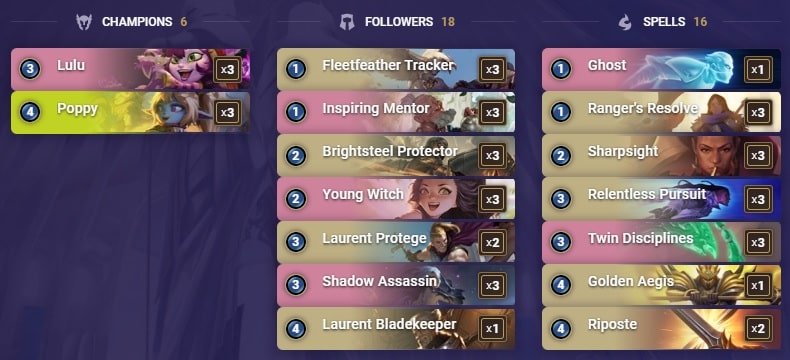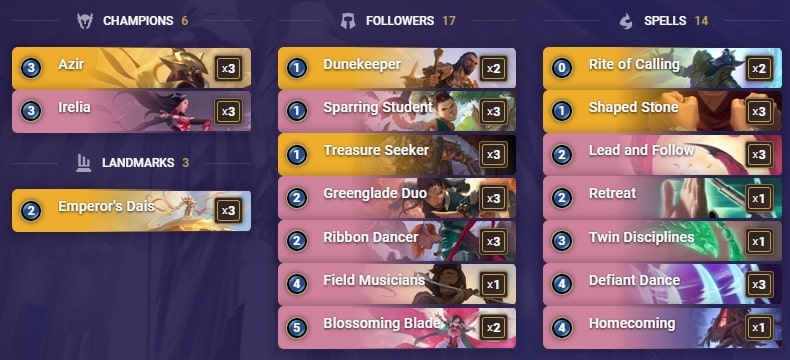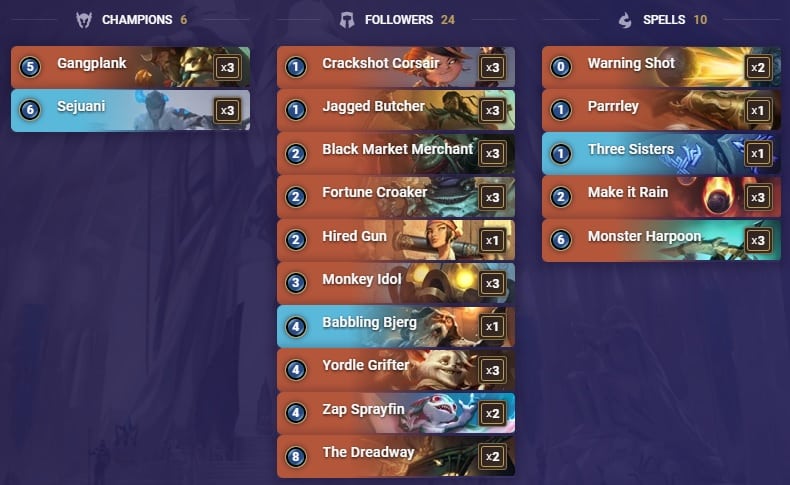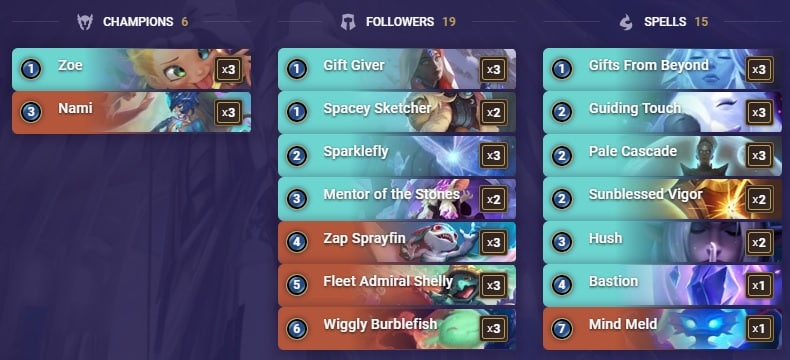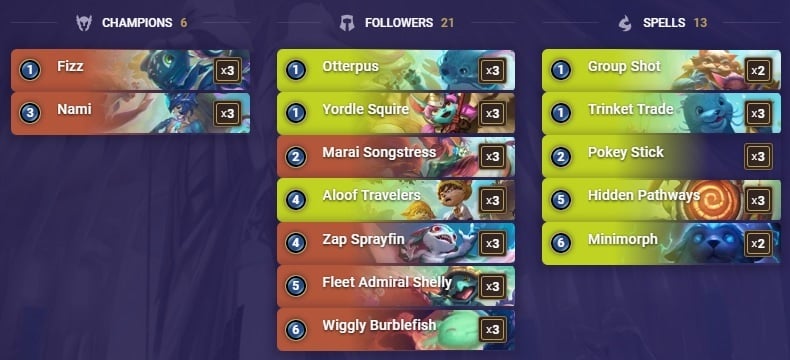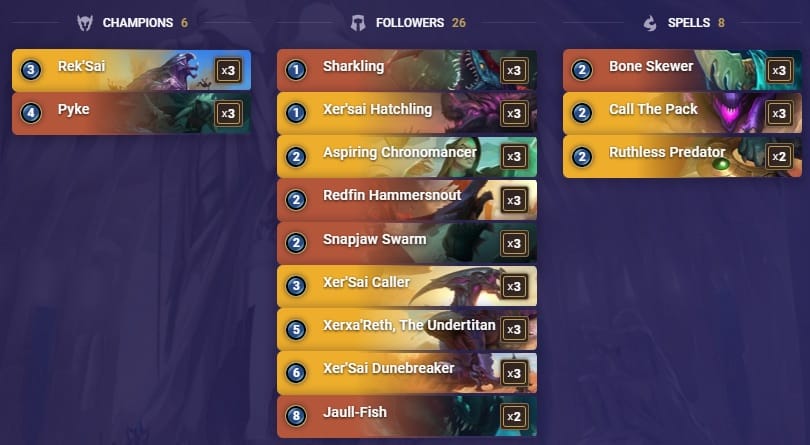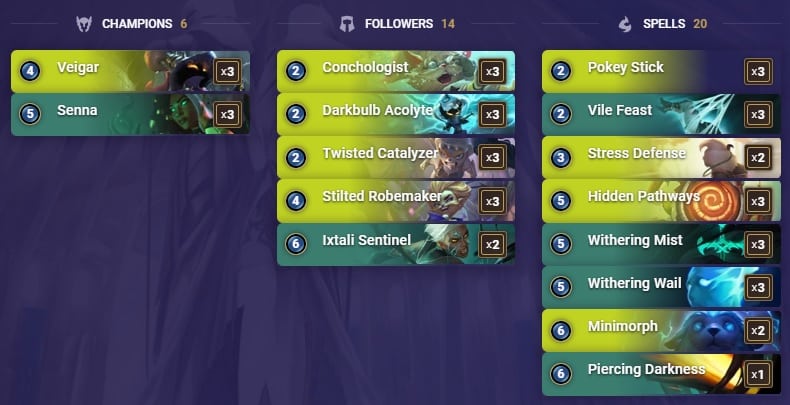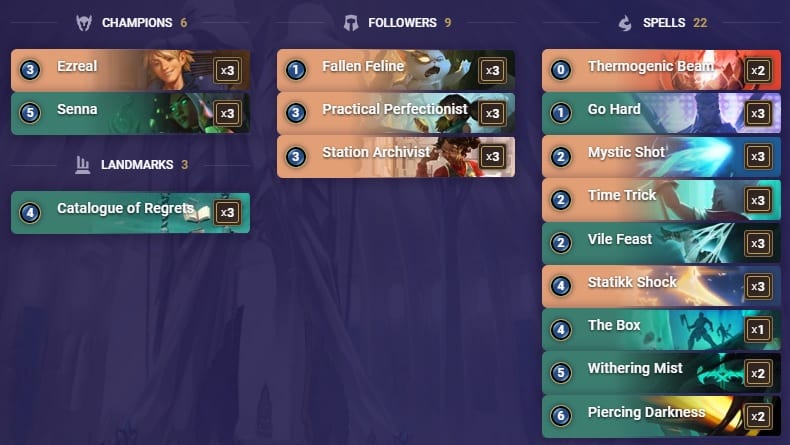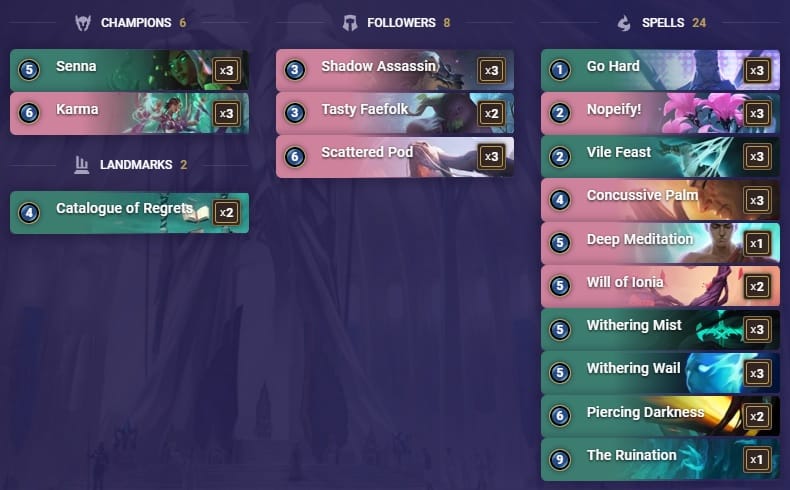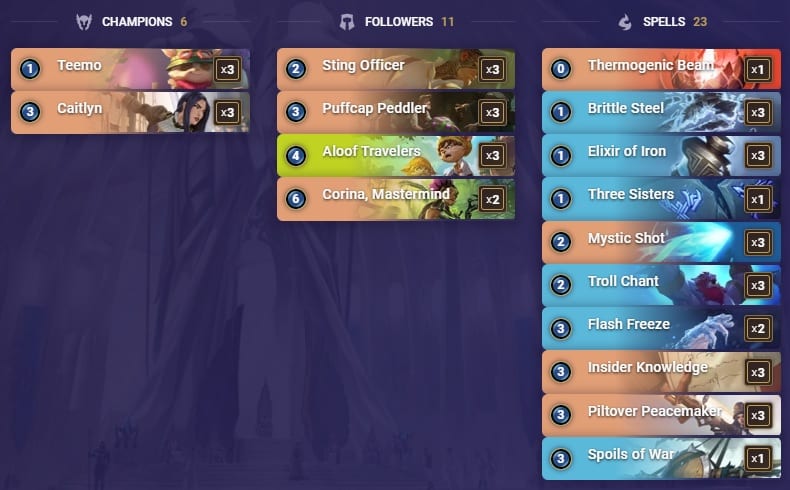Welcome to TLG’s latest meta snapshot for Legends of Runeterra, a series in which we give you our insight on the finest decks in the higher ranks of the ladder.
Every Monday, we discuss the decks that are part of the week’s meta and rate them on a scale of 1 to 5 stars. We also look at the evolution of said decks’ ratings across weeks and draw conclusions regarding the current state of the game, all of this so you can delve into your own ranked journey with a head start.
There are new and old faces in Bandle City, some that will be looked upon with disdain and others that will be cherished. Wherever you stand, there will be something for you here. That could be the Yordle fest in Lulu-Poppy, the long-awaited fleshing out of Puffcaps, or the dominance of Sion Discard.
Whatever you deck choose, enjoy this period of experimentation before the inevitable refinement in the weeks to come.
If you have any questions, feel free to drop by our Discord. Best of luck on your climb!
Graphics: WellMax81
Editing: Wusubi, Sebodunum
Writers: Den, Ultraman, Othal

CMBQCAYABYBACAAJDUDQIBYNCQ3DOXLHQIAQIAIBAANACAQAAEAQIAADAECAPAABAIAQIAACAECAPCQB
Difficulty: Moderate
After a few days of meta working itself out, the totally-super-duper-unexpected thing happened: the strongest deck which has received literally no balance changes, is still the best. Get your surprisedpikachu.jpg ready for... Akshan-Sivir! Boasting over 20% play rate and 63% win rate, the deck is still at its prime, and thrives against slow combo decks.
Shurima/Demacia is an incredibly potent pairing, with combat tricks and removals aplenty to deal with backrow units like Azir, Nami or Ava Achiever. While you may not have as many buffs readily available as in the Ionia version, it’s compensated by the number of challenges you can issue via Fleetfeather Tracker, Merciless Hunter or even Cataclysm. Sharpsight is also handy in a meta bristling with Elusives like Teemo or Fizz.
The game plan is simple: to crush your enemies and to hear the lamentation of their women. Everything in your deck is a threat that your opponent won’t be able to value trade with thanks to your Challengers and combat tricks, and each piece of damage you deal goes towards leveling-up Sivir.
Use Golden Aegis wisely, and remember that Cataclysm procs an Attack and not a Strike, so damage from Overwhelm works! Akshan may look a bit out of place, but he’s an incredible value tool, providing you with a trigger for Shaped Stone while acting as a draw engine and a Quick-Attack threat.
Any unit you put on the board should stick, and when paired with a leveled-up Sivir... let’s just say that many Surrender buttons will be mistreated on this day. (Write-up by Othal)
CECQCAYECIAQCAYUAEBQGDYDAECACJZNAYCQGAIEAUDASDIBAECAIEACAEAQGIYBAECCM
Difficulty: Moderate
Currently, 2 decks are looking a bit out of line. The first is Akshan-Sivir, which we already knew would still be the deck to beat. The other is Discard, which went from a middle of the pack Aggro deck to the most feared opponent one might encounter on the ladder over these last few days.
What changed the most in the deck isn’t its aggressive potential - quite the contrary actually, as Discard now looks more like a Midrange grinder that’s capable of playing full mana turns for longer than most decks in the meta.
This newly found success came with the new cards, namely Lost Soul and Grave Physician, who both helped the deck find the best sustain. But where the deck really became an all-rounder is that it also gained firepower in the process. Reborn Grenadier and Ancient Warmonger are 2 cards that are capable of turning a board that’s manageable into a very dangerous one.
Lastly, Sion is the cherry on the cake. He might be the best finisher in the game, beating Ruin Runner to that title. Incredibly easy to level-up, he always comes down on the board looking like the game is over if he isn’t immediately dealt with.
But where the champion shines and makes a huge difference compared to Darius, for example, is in his ability to impact the game at multiple points. He can grant Overwhelm to allies when discarded, which puts him back in the deck anyway.
The sky is the limit for the Discard archetype. Being the only deck that can hold its ground against Akshan-Sivir is proof of its already formidable power. The Shurima/Demacia pairing, however, has already hit its peak - if Discard finds some more room for refinement in the next few weeks, we may see an upset at the top of the rankings. (Write-up by den)

Caitlyn-Draven
CEDQCAQDBEAQIBAQAECQVGABAEBQIEICAECCMNACAEBRILQCAUCAMDICAEAQIGYBAEBTGBIBAECC2AIEAQBQCAYDBUAQEBABAIAQGFRD
Difficulty: Moderate
This might be news to you, but Draven is a great champion. In fact, he might be vying for the title of best in the game that Sivir looks to be holding currently. He carries the Noxus/PnZ pairing and alongside the Discard archetype, he can brag about being the champion with the most competitive pairings under his belt.
We have combined two decks here under the same banner, as both are Midrange lists looking to outpace the opponent while trying to include as many 3-cost cards as possible for Tri-beam Improbulator. Despite these similarities, there are considerable differences between them as well.
Caitlyn pushes for a faster pace in the early to mid game, relying on Flashbomb Trap to damage the opponent, setting up easier removal for Ravenous Flock, Scorched Earth, Noxian Guillotine or the damage-based spells. She’s a nightmare for Aggro decks that have to take risks to close the game out before the traps can damage their board, forcing valuable time and resources to remove her before going back to their original game plan. (Write-up by den)
Ezreal-Draven
CEDACAQDBEAQIBAQAECQVGABAEBQIEICAEBRILQEAECB6JBGGQBACAIEDMAQCAZTAQAQCBBHAEBQGDIBAICACAYBAMLCGNY
Difficulty: Moderate
Ezreal, on the other hand, pushes for more of an off-tempo rhythm, where we’re fine with playing slower, as it gives us more time to level him, which is a key win condition (unlike Caitlyn’s level-up). Because of this difference between both champions, Ezreal is better against defensive decks, who wouldn’t care much about Flashbomb Trap being triggered.
Power level wise, this archetype could very well be the best in the game if it wasn’t for the two powerhouses in Tier S. These are, unsurprisingly, the two unfavored matchups. Even less surprisingly, they’re rather popular at most ranks of the ladder.
Discard is strong, because it virtually never runs out of gas, which compliments the out-tempo idea Ezreal-Draven tries to push. Sivir and Ruin Runner in the other deck simply have the SpellShield cheat code, which forces us to expend more resources than planned in order to deal with them.
This simple fact is holding both deck back from being much higher in our rankings, but as murmurings are starting to be heard about potential nerfs to at least Akshan-Sivir. Naturally, Discard decks would benefit from such changes. (Write-up by den)
CQDACAQAA4AQGAAOAECQUKICAMBAECQDAEAASFI5AMAQEDA2HEAQEAIABMSQGAIBAABQCAICCYAQIAAC
Difficulty: Easy
We talked about Lulu-Poppy in our deck report last week, and it continues to be the deck to look out for. Following the tradition of Demacian multi-attack decks, you’ll keep your opponents on their toes for as long as there’s something to attack with.
Poppy is a natural fit with Lulu, as she helps to make anything from the 1-drops to the bigger units feel like threats. Her buffs also help with the survivability of everything else, which is another key point to the deck’s success. Poppy’s level-up of +2/2 and Impact to allies can be devastating with a wide board, and Rally spells will often seal the deal.
The main question left in what’s basically an update to Lulu-Zed is how to protect our units. Currently, there are 2 juggernauts, namely Akshan-Sivir and Sion Discard, who can force us into trading and have the opportunity to out-value us in the late game.
Both of the Tier S decks pack Elusive units or ways to answer them, which removes one of the best damage opportunities we might have, meaning we have to accept a board battle and find a way to keep our champions alive for several turns.
For that reason, this deck is shying away from the Elusive mechanic and packing more barriers and combat tricks to keep its key pieces alive. In other matchups though, where the board is easier to develop, the deck really shines and is able to punish the slower decks that have emerged in the Bandle City expansion, such as Darkness or the Nami variants.
Clearly one of the rising decks, it’s only outshined by Sion Discard in terms of lists featuring a new champion. That’s quite an achievement, so, there’s no doubt Lulu-Poppy should be one of the decks to look closely at if you enjoy applying the pressure with board-centric strategies. (Write-up by den)

CMBQEAICAYVAIBACAUEASCYEAQDQGMZWLUBACBACAQBAIBY2PECACAICBQAQEAQKAEBQEBIBAQBAC
Difficulty: Easy
The old threat is still present, and it preys on newer builds with ease. Its high flexibility allows the deck to play slower and then avoid every one of the opponent’s removals, while forcing them to take poor trades, lose HP, and little by little allow you total control of the board.
Lead and Follow, Shaped Stone, Twin Disciplines, Retreat and Homecoming will do much to tilt your poor opponents, who are just trying to get a spell to hit home in order to stop the waves of Sand Soldiers eroding their Nexus.
Azir and Irelia take some time to level-up, but once one of them is flipped, it’s already extremely hard to deal with the pressure. In reality, it’s close to impossible if both champions are on the board.
By now, you all know Sparring Student and Greenglade Duo, two cheap cards that grow to frighteningly high statlines in this mass-summon archetype if not taken care of early. Azir-Irelia can now be seen as a classic deck, reminding newcomers of the time it once terrified the ladder, and why! (Write-up by Ultraman)
CICACAQBAIAQGBQIAECAMCQHAIDAWIBBEIWTUPABAMBAMAQUEYBQCAIBA4AQIAIKAIBAMBIS
Difficulty: Moderate
GP-Sejuani still retains an amazing curve, pressuring the newcomers and beating them as soon as they miss specific removals. It can also work through pure pressure, with a Gangplank finishing the job with his high damage potential.
Sejuani’s level-up is of course the deck’s main appeal, being able to freeze followers behind their SpellShield. This can be a big advantage against Akshan-Sivir, the ladder’s biggest problem. The deck is also able to deal with aggression efficiently, due to Make it Rain and a great curve to match the opponent’s early threats.
Monster Harpoon is a powerful spell, being able to deal with most followers for 3 mana, if you have Plunder activated that turn. Warning Shot is there to make sure you achieve this for free. (Write-up by Ultraman)
Zoe-Nami
CICACAQGEYAQGBQRAICQMBILAYBQSCJDFAYDHVYBAECAGCJJKVLGEAQBAIDCUAIDBEJQ
Difficulty: Moderate
If you want to relive the glory days when My Chemical Romance and pirate metal were walking hand in hand on the ladder of Runeterra fear not: you can now feel the same sensations, just with 89% less edginess. Aphelios and Twisted Fate are gracious losers and leave their place to the more feminine team of Zoe-Nami.
This list has a simple game plan and a lot of options. While you’ll usually just try and survive the early game to build a board of Elusives you can boost with Nami, this deck provides answers for most matchups. Against Aggro, abuse Sparklefly and Mentor to get some free healing every turn. Against Midrange decks, use Nami to get the biggest units you can. You’ll suffer against control decks though, so stick to the plan and get to winning!
Leveling Nami is the most important task, so you’ll need to manage your spell mana carefully: if your reserve is full, you won’t gain more spell mana and thus will be stuck. But if you use only spell mana and don’t play creatures on the board, you’ll open yourself to threats and direct attacks while also slowing your win con, which is making the enemy Nexus explode.
Zoe is here to help you get early pressure, some low-cost spells to empty your spell mana reserve, and also some much-needed flexibility from her pool of Celestial Cards. Getting her to level-up isn’t necessary, so don’t focus on keeping her alive when Nami has a bigger impact on your strategy - alhough having a board full of Lifesteal Elusives thanks to Sparklefly is a joy known only to a few chosen ones. (Write-up by Othal)
Fizz-Nami
CECAEAQGEYXAMBIKAQNCREIBTAA2MAIDAUDAKCYNAEBQMEIBAICQUAOGAEAA
Difficulty: Moderate
The Fizz pairing has also seen some play, trading the versatility of Targon for the draw power and Prank package of Bandle City. You have access to more low-cost creatures and more information about your opponent’s hand, besides Fizz is a more durable champion than Zoe.
You’ll also probably provoke some rage and frustration when you turn a huge Sion into a cute little seal via Minimorph, so that might be a legitimate option! (Write-up by Othal)
CMBAKBAGAEBAGBIPA4CAOAITCZAUISSQAIAQIBQHAECAORIA
Difficulty: Moderate
While not as popular as when they were released, Lurkers are where they’re comfortable: under the radar and ready to strike. The most efficient lists moved away from the OTK combo approach that was prevalent in the previous meta and turned the deck into an Aggro one. The high-roll and Predict packages were toned down in favor of a more “straight-in-your-face” build. After all, you cannot miss your Lurks if your deck is full of Lurkers.
Your followers have lower-than-efficient statlines, so you’ll need to be clever in your attack timings and use Snapjaw Swarm to make sure you proc as many boosts as possible. Sometimes, giving your opponent a value trade is worth it, as it might allow you to gain +26 Attack between all units while helping Death from Below go above the HP threshold of a backline champion. You might even get a Rek’Sai proc and win the trade anyway.
Pyke is still one of the best cards in the deck, even more so in his spell form - but that shouldn’t prevent you from playing him, attacking, and putting him back in with a well-timed Bone Skewer. You can even get two of them in if you play one and use Death from Below to summon another.
Just imagine the power! Every piece of damage you deal is a step closer to his level-up, which essentially means destroying the whole enemy board with just 4 mana, so you can be greedy and go all-in without remorse. That’s in-character anyway.
Even if the deck is played as an Aggro one, don’t hesitate to slow down and build a board against the more resilient opponents, attacking with the less valuable units in your hand to proc Lurks, creating value with Call the Pack. You’ll have several ways of swinging the tempo back in your favor via a Jaull-Fish or a flipped Pyke ready to clear the enemy threats. (Write-up by Othal)

CQCACBAFHAAQKBIJAIAQKHJIA4CQUGRRHFOV4YVGAEBACBIFBABAKCQB2EAQCAIFAUBQ
Difficulty: Easy
Veigar is a fan favorite who most people truly want to see put in the work - but he struggles to live up to these expectations in this incredibly tough meta. Although he can swat aside unrefined decks that forget to pressure him, his abysmal lack of tempo makes him a perfect target for fast, bulky Midrange lists - which just so happens to be most of the top tier decks right now.
He also lacks reactive abilities. Darkness is useful as removal, but it’s proactive removal (until Senna comes online), which can be sidestepped by Recall spells like Lead and Follow or combat tricks (Sharpsight, Troll Chant, Shaped Stone). Your best set-up is, surprisingly, not having Veigar on board, but Senna.
Her base form speeds up damage and spells from Slow to Fast and her level-up reduces their cost by 1. As such, you can finally gain tempo on your opponent and answer their threats. Finally, the fact that she creates multiple versions of Darkness helps to level-up Veigar and keeps your hand full with the now-reactive removals!
A common tech choice is to kick Stilted Robemaker for Aloof Travelers. This gives you more hand disruption but less synergy. This might be a meta call, as some threats are too hard to answer once on the board (and much better when visibly discarded from the opponent’s hand). (Write-up by Ultraman)
Ezreal-Senna
CEDAGBAEAIDQYAIDAUIAGAIED4SDIAIBAUUACBIEBQBAKBIJBYBQCAIEDMAQIBJYAECQKAYBAEAQKEY
Senna-Karma
CEEACAYFCAAQGAQUAIAQKHJIAIAQEKJZAEBAEBIBAUCQSAIEAU4ACBACCQBQCAYCBEBAKBIDBYAQCAQCAIAQEAQJAEAQKDY
Difficulty: Easy
When Senna was revealed, everyone knew she would be part of the Darkness archetype. But the promise of spells becoming Fast also brought some other stuff to life: who hasn’t dreamt of using a perfect Thermogenic Beam against an open attack? Who doesn’t want to cast 2x Darkness for 3 mana?
Senna decks all play along the same lines, but P&Z and Ionia bring different win cons at the cost of a loss of synergy, and the loss of Veigar’s evil laugh and epic level-up animation. The game plan remains similar, namely using your spells to slow down the game, which allows your champions to come online while staying healthy and out of threat range.
Catalogue of Regrets is here to provide unlimited value, but you’ll need a bit of planning to make sure you have the mana to play the fleeting spell it generates and put another spell in its pages. This is helped by the flurry of low-cost spells you’ll have access to, including the infamous Go Hard.
Go Hard is your main win condition, so use it wisely. While you might want to play it as soon as you get it, Senna decks lack the draw of Bilgewater, and you might dilute your deck with cards that lack any impact before the combo is on and thus not draw your champions when you need them. Try to evaluate if you have everything you need in hand before transitioning to Go Hard.
When Senna is leveled-up and Catalogue of Regrets on the board, the reflection becomes a lot easier: you can play Go Hard at Fast speed and will probably generate another one on the following turn.
This will help with your finisher: playing your third Go Hard and the following one - turning into Pack your Bags - on the stack at Fast speed for 0 or 1 mana. With a flipped Ezreal or Karma, the impact usually turns the opposing Nexus into a smoking crater. (Write-up by Othal)
CECQCAYBAIAQKCUYAEBACAIEDYBQCBAIDE2AIBIEAIDASDICAEAQCAIBAUCA4AQBAECBWAQEAEFBA
Difficulty: Moderate
Teemo has found a trap buddy, and it might be enough to start taking the archetype seriously. First, it makes a difference in the way the deck operates, as the Flashbomb Trap helps deal with the opponent’s board, punishing swarm strategies - something the deck struggled with in the past.
Secondly, Caitlyn and Corina, Mastermind give the deck a new dynamic in terms of damage, greatly reducing the need to make the opponent draw, which could offer them additional options. Instead, the deck now tries to stall the game while shuffling the traps and then activate them through Corina for a huge burst of damage.
Your opponent’s card draw is more controlled and instead of Hexcore Foundry, we include the new Insider Knowledge spell as another Flashbomb activator, helping to reduce the opposing aggression in emergency cases. Otherwise, it can always activate some Puffcaps later on, or simply serve as refill if we’re lacking defensive options.
This deck is rated so low mostly due to the inherent randomness of the traps mechanic. When everything clicks and Caitlyn levels-up or Corina triggers tons of Puffcaps, we could rate it at 5 stars. The problem is that when the traps aren’t in our favor, we’re stalling while doing nothing and eventually we get outpaced by our opponent.
With more refinement, the deck could end up being relevant in the long run. This would make a welcome change from the infuriating “counter” tag it has been labeled with for a long time now, only shining against control decks. (Write-up by den)

